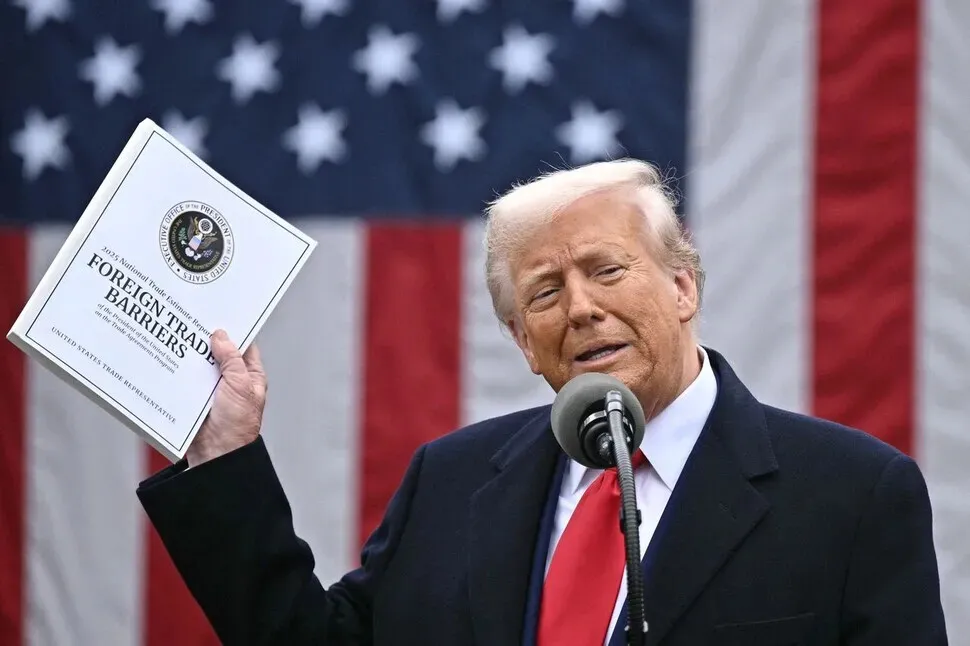hankyoreh
Links to other country sites 다른 나라 사이트 링크
Trump upends global trade with sweeping retributive tariffs

US President Donald Trump announced Wednesday that imports from 57 of the US’ biggest trading partners would face “reciprocal” tariffs of up to 50%. Korean-made goods, in particular, will face 25% in tariffs. A baseline tariff of 10% will apply across the board to items imported from other countries, with over 100 countries impacted by Trump’s announcement. The tariffs, which are far tougher than experts expected, are likely to suppress trade and pummel the global economy.
Trump announced his reciprocal tariffs in a speech from the Rose Garden at the White House on Wednesday afternoon. The tariff rates on major trade partners break down as follows: 25% for Korea, 34% for China, 20% for the EU, 46% for Vietnam, 32% for Taiwan, 24% for Japan, 27% for India and 10% for the UK.
Simply put, Trump is applying a baseline tariff of 10% to all imports and even higher “reciprocal” rates on countries he regards as particularly bad offenders.
The tariff for Korea was listed as 25% on a poster Trump held up during the press conference, but as 26% in the annex to the legally binding executive order. The confusion was eventually cleared up when the annex was revised to show 25%.
The main justification given by the US for its reciprocal tariffs is non-tariff barriers to trade. Trump remarked that non-monetary barriers are worse than monetary barriers while holding up a yearly report on national trade barriers published on March 31 by the Office of the US Trade Representative (USTR).
The 10% baseline tariff will apply to all imports at 12:01 am EST on April 5, and the reciprocal tariffs will take effect at 12:01 am EST on April 9.
Trump didn’t rule out the possibility of negotiations.
The White House said in a statement that the tariffs will be maintained until such a time as Trump decides that the trade deficit and nonreciprocal treatment have been mitigated or resolved. The same statement also noted that Trump could raise tariffs if trading partners retaliate or lower them if those partners rectify nonreciprocal trading arrangements.
The new tariffs do not stack on tariffs already applied to steel, aluminum, and automobiles (both assembled vehicles and parts). Certain mineral and energy resources that are not easily sourced inside the US are exempted from these tariffs.
In a critical editorial, the Wall Street Journal said the tariffs represent a return to protectionism and would have severe consequences for both the US and the world economy.
“The era of increasingly free and extensive international trade, built upon a rules-based system that the US was instrumental in shaping, has drawn to an abrupt end. Rather than fixing the rules that many US trading partners admittedly took advantage of to their own benefit, Trump has chosen to blow up the system governing international trade,” said Eswar Prasad, a professor of trade policy at Cornell University.
The Korea Center for International Finance said Thursday that an analysis of the US’ reciprocal tariffs’ impact on the global economy showed the tariffs would reduce the global economic growth rate by around 0.49 points from previous projections each year from now until 2028.
That means the tariffs could wipe out around 2.4 quadrillion won (US$1.67 trillion) of growth over the next three years.
“That calculation assumes that only the US’ tariffs take effect. If China, Europe and other players retaliate to the baseline tariff with 10% retaliatory tariffs, the growth rate will fall by 0.8 percentage points,” the center said.
Countries around the world criticized the move by the US. China promised to take stern measures to “safeguard its own rights and interests.” The EU said that it was preparing a response, and Japan also expressed regret.
Korean acting President Han Duck-soo only called for officials across the government to “quickly devise emergency support measures for affected companies and industries.”
By Kim Won-chul, Washington correspondent; Lee Jeong-yeon, Beijing correspondent; Hong Seock-jae, Tokyo correspondent; Jang Ye-ji, Berlin correspondent; Cho Kye-wan, senior staff writer
Please direct questions or comments to [english@hani.co.kr]
Editorial・opinion
![[Column] USFK’s existential crisis [Column] USFK’s existential crisis](https://flexible.img.hani.co.kr/flexible/normal/500/300/imgdb/original/2025/0413/7017445017131603.jpg) [Column] USFK’s existential crisis
[Column] USFK’s existential crisis![[Editorial] Acting president’s nominations are procedurally and substantively unacceptable [Editorial] Acting president’s nominations are procedurally and substantively unacceptable](https://flexible.img.hani.co.kr/flexible/normal/500/300/imgdb/original/2025/0409/9717441872547983.jpg) [Editorial] Acting president’s nominations are procedurally and substantively unacceptable
[Editorial] Acting president’s nominations are procedurally and substantively unacceptable- [Column] After Yoon, Korea must reckon with its imperfect democracy
- [Column] Yoon’s out — here’s how we end this crisis for good
- [Column] The work isn’t over yet for Korean democracy
- [Column] Ripping up constitutions
- [Editorial] Yoon’s ouster is a victory for popular sovereignty and an opportunity for progress
- [Correspondent’s column] Wearing a MAGA hat in the immigration line
- [Editorial] Constitutional Court must at long last remove Yoon
- [Column] Don’t let insurrectionists gaslight you
Most viewed articles
- 1Tulsi spent 4 years dreaming of life in Korea. Within 6 months of arrival, he was dead.
- 2[Column] USFK’s existential crisis
- 3Real-life heroes of “A Taxi Driver” pass away without having reunited
- 4The harrowing real-life stories of the Korean military coup depicted in “12.12: The Day”
- 5Foreign students rethink Korea as expectations are dashed by harsh realities
- 6Gangnam murderer says he killed “because women have always ignored me”
- 7South Korea establishes diplomatic ties with Syria
- 8Video evidence surfaces showing Korean comfort women were massacred by Japanese military
- 9ILO chief says he is closely watching labor union persecution in S. Korea
- 10With a click, 220,000+ member Telegram room generates illegal deepfake porn